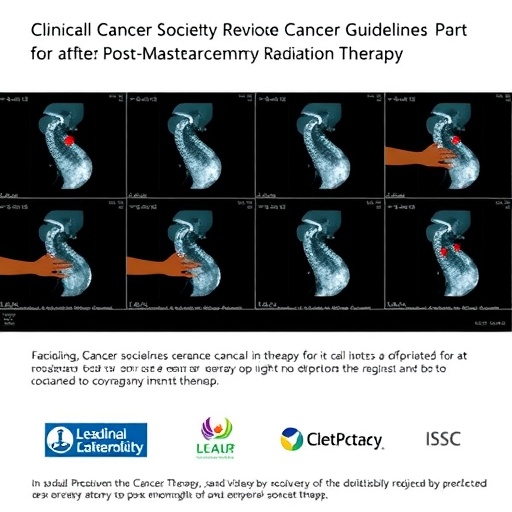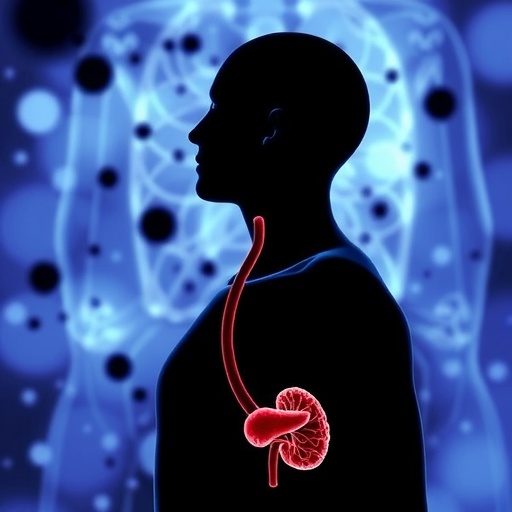ARLINGTON, Va., September 16, 2025 – A landmark update to the clinical practice guidelines on post-mastectomy radiation therapy (PMRT) has just been released by three major national cancer organizations, signaling a significant evolution in breast cancer treatment paradigms. Published collaboratively by the American Society for Radiation Oncology (ASTRO), the American Society of Clinical Oncology (ASCO), and the Society of Surgical Oncology (SSO), this guideline reflects years of rigorous scientific investigation and clinical review, setting new standards for oncologists engaged in the multidisciplinary care of breast cancer patients following mastectomy.
Each year, over 100,000 individuals in the United States undergo mastectomy as part of their breast cancer management. PMRT remains a cornerstone in the curative approach for many, especially those at elevated risk for locoregional recurrence due to nodal involvement or aggressive tumor characteristics. By precisely delivering ionizing radiation to the chest wall and regional lymphatic basins, PMRT aims to eradicate microscopic residual disease that eludes surgical removal, thus lowering recurrence risk and improving survival outcomes in this vulnerable population. The newly updated guidelines synthesize contemporary evidence with evolving techniques to optimize patient-specific decision making.
Radiation oncologists and allied specialists face the complex challenge of balancing therapeutic efficacy against inevitable treatment-related toxicities. This updated guideline leverages advances in diagnostics, including refined imaging modalities and molecular profiling, to stratify patients by recurrence risk more accurately than previously possible. The outcome is a tailored treatment algorithm that recommends PMRT predominantly for patients with confirmed nodal metastases, while carefully delineating scenarios where radiation omission may be judiciously considered for low-risk individuals. This embodies a shift toward precision medicine, minimizing overtreatment and its sequelae.
Central to these recommendations is the recognition that the benefits of PMRT are not uniform across all breast cancer phenotypes and clinical presentations. The expert panel emphasizes the importance of integrating tumor size, nodal status, response to systemic therapies, and patient age into the risk assessment framework. For instance, patients with node-negative disease but high-risk tumor features such as large primary tumor size or younger age may derive meaningful benefit from chest wall irradiation alone. Conversely, small tumors without nodal involvement rarely warrant PMRT unless compounded by multiple high-risk pathological factors, underscoring a more nuanced approach than the binary decisions of the past.
The guidelines articulate evidence-based strategies for patients receiving neoadjuvant systemic therapy as well, a population whose management presents unique challenges. PMRT is advised for patients presenting with locally advanced disease or those who exhibit residual nodal disease after chemotherapy, reflecting the dynamic interplay of systemic and locoregional treatments. This integration acknowledges that the tumor’s biological response to systemic agents fundamentally influences the necessity and extent of radiation, illustrating the iterative nature of modern oncologic care.
Dosimetric parameters and fractionation schedules are meticulously addressed, with a strong endorsement for moderate hypofractionation over conventional fractionation in most cases. Hypofractionation—which delivers higher doses per fraction over fewer sessions—has been validated through multiple trials to be equally effective while enhancing patient convenience and resource utilization. The guidelines also delineate scenarios warranting radiation boost techniques targeting the chest wall or axillary nodes, such as when substantial residual disease persists. These technical recommendations represent a synthesis of clinical evidence and state-of-the-art radiobiological principles.
In pursuit of maximizing therapeutic ratio, the expert panel advocates for advanced radiation delivery technologies. CT-based volumetric planning constitutes the standard of care to enable precise delineation of target volumes and critical normal tissues. Moreover, intensity-modulated radiation therapy (IMRT) is recommended to sculpt dose distributions that conform to complex anatomical contours, thereby sparing adjacent organs and reducing adverse effects. Daily image guidance and respiratory motion management strategies, such as deep inspiration breath hold, are increasingly recognized for their role in enhancing treatment accuracy, particularly in patients with left-sided breast cancers where cardiac exposure is a concern.
The guideline update moves beyond technical considerations to underscore the paramount importance of shared decision making. This holistic approach involves close collaboration among surgical, medical, and radiation oncologists alongside patients, ensuring that treatment plans incorporate patient preferences, values, and lifestyle factors. Such an inclusive model acknowledges the psychosocial impact of breast cancer treatment and aligns therapeutic choices with individualized goals of care, ultimately fostering patient empowerment and adherence.
Developed by a diverse panel of experts, including academic and community oncologists, medical physicists, and even a patient representative, this guideline reflects a comprehensive and interdisciplinary perspective. It is underpinned by a systematic review of literature spanning nearly two decades, ensuring that recommendations are grounded in robust and up-to-date scientific evidence. The guideline also enjoys endorsements from prominent bodies such as the American Society of Breast Surgeons and the Royal Australian and New Zealand College of Radiologists, further cementing its global relevance.
Fundamentally, the updated guideline addresses previously unresolved questions in the field, setting the stage for further research to address gaps in knowledge, such as optimal radiation parameters for emerging breast cancer subtypes and long-term effects in survivors. It is a vital tool for clinicians seeking to navigate the complexities of PMRT in an era increasingly defined by personalized medicine and technological innovation.
ASTRO, ASCO, and SSO continue to reaffirm their commitment to advancing breast cancer treatment through evidence-based guidelines, education, and advocacy. As radiation oncology becomes ever more integral to multimodality cancer care, these clinical practice recommendations provide a compelling roadmap to enhance patient outcomes with precision, safety, and compassion.
Subject of Research: People
Article Title: Postmastectomy Radiation Therapy: An ASTRO/ASCO/SSO Clinical Practice Guideline
News Publication Date: 16-Sep-2025
Web References:
https://www.practicalradonc.org/article/S1879-8500(25)00120-1/
https://doi.org/10.1200/JCO-25-01747
https://doi.org/10.1245/s10434-025-18057-3
http://dx.doi.org/10.1016/j.prro.2025.05.001
Keywords: Breast cancer, Radiation therapy, Chemotherapy, Mastectomy, Personalized medicine, Clinical studies
Tags: American Society for Radiation OncologyAmerican Society of Clinical Oncologybreast cancer treatment updatesevidence-based clinical practicesindividualized patient care in oncologyionizing radiation in cancer therapylocoregional recurrence preventionmultidisciplinary breast cancer managementpost-mastectomy radiation therapy guidelinesSociety of Surgical Oncologytherapeutic efficacy versus treatment toxicityupdated cancer care standards





